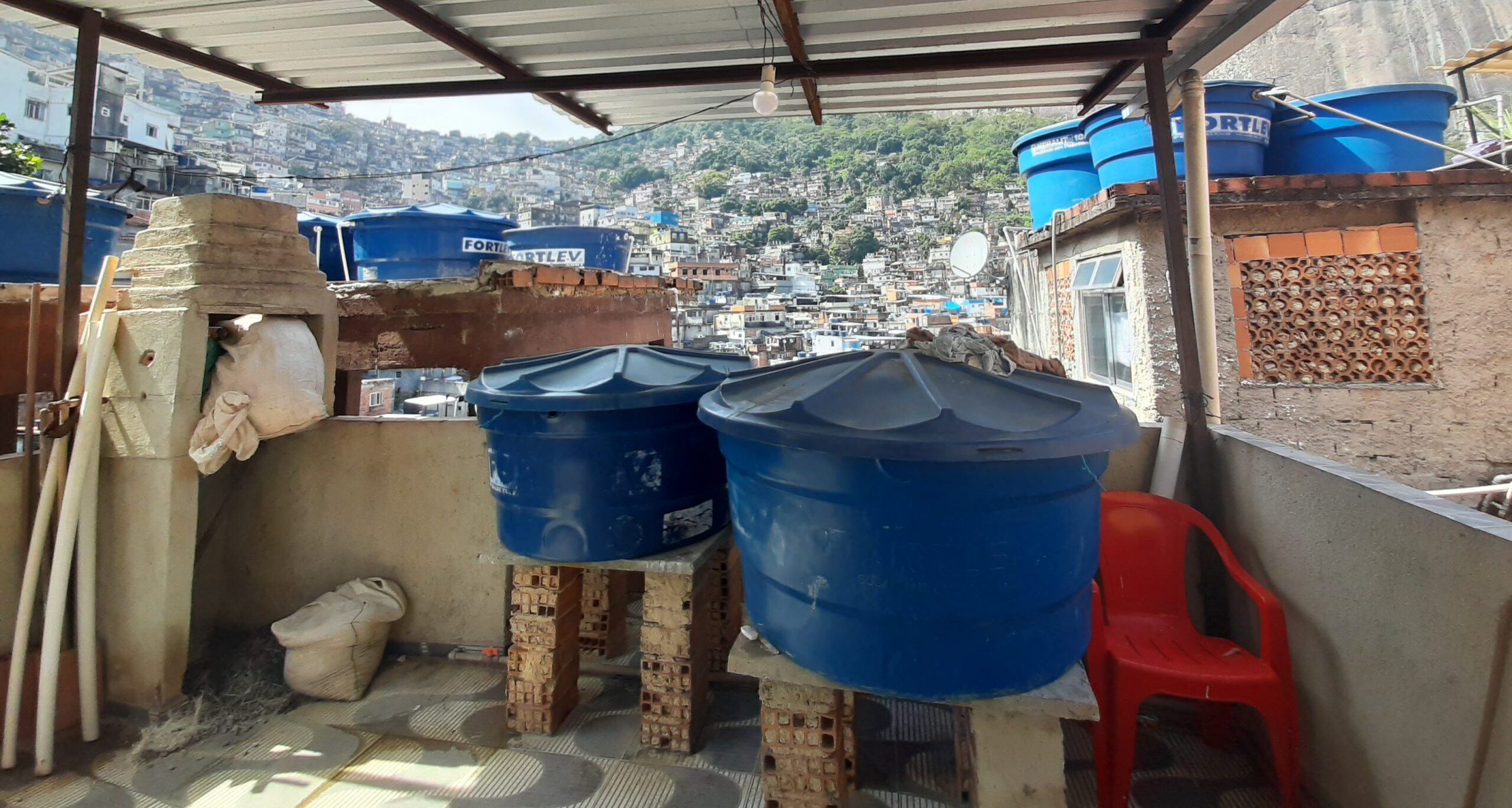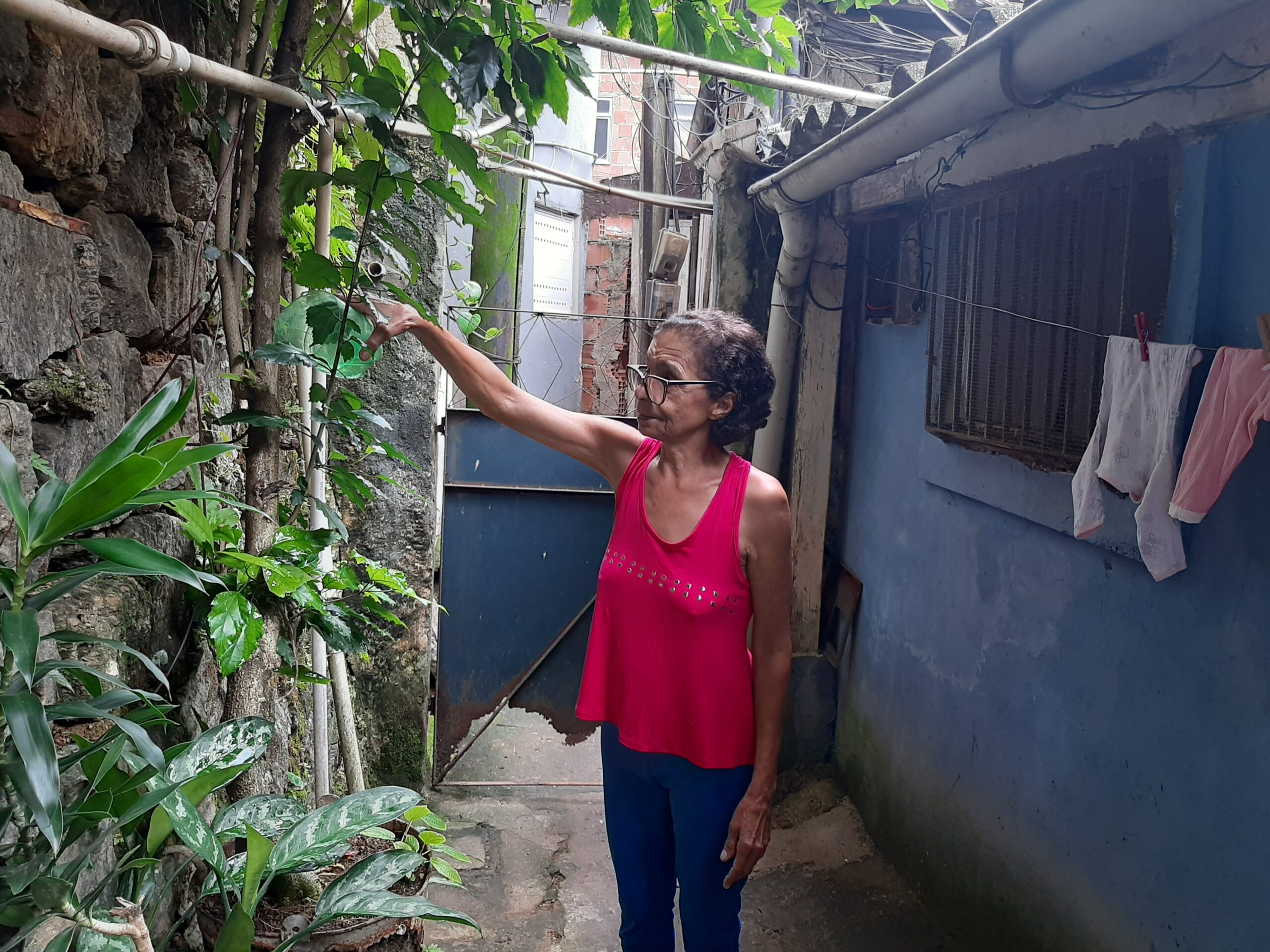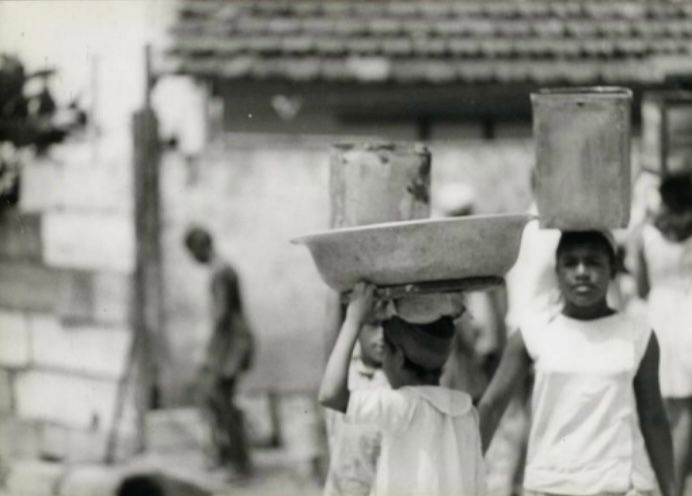
Clique aqui para Português
This is the first in a series of articles on water justice in the favelas resulting from the course “Climate Justice in Community Journalism: From Pitching to Writing.” The course, conducted by the RioOnWatch team in collaboration with the Sustainable Favela Network (SFN) Youth Working Group took place between July and September 2023.
As part of the urban landscape, the water storage tank stands as a fundamental component of the structure of any house or building in Rio de Janeiro, representing the harsh reality of frequent water shortages in the city. Like other favela neighborhoods, Rocinha, the largest favela in Rio, located in the South Zone, has grappled with more extreme water shortages for decades—an enduring struggle woven into the lives of residents.
In 2020, the government of the state of Rio de Janeiro, along with former utility State Water and Sewerage Company (CEDAE) and the current private water utility Águas do Rio, included Rocinha in the Community City program. The initiative states its aims as improving living conditions by implementing projects related to water supply, sanitation, mobility, housing, solid waste collection, and public facilities. The investment for basic sanitation, including water, sewerage, and drainage networks, amounted to R$1 billion (US$203.4 million). Designed to benefit approximately 122,000 inhabitants, the effort estimated the need for 7 million liters of water.
Rocinha’s current supply system is made up of three strategically located reservoirs: Navio, with a capacity of 1,700,000 liters; Terreirão, holding 440,000 liters; and Laboriaux, with a capacity of 60,000 liters. Together they total 2,200,000 liters. The more than four million liters still needed to end water shortages in Rocinha would be stored in new reservoirs which were said to be built as part of the project. However, the plan never came to fruition and reports of water shortages have continued over the years.
Discrepancies in historical data regarding the favela’s true number of residents have consistently hindered the development of policies aimed at improving residents’ quality of life. For example, based on 2010 IBGE data, the water supply, already inadequate for the 70,000 residents at the time, would have averaged 31.5 liters per person per day. However, considering the population figure of 122,000 inhabitants from the Community City program, current consumption drops significantly to just 18 liters per resident.
According to the United Nations (UN), each person needs between 50 and 100 liters of water per day to meet their basic consumption and hygiene needs. The insufficient amount available to residents of Rocinha highlights the State’s negligence in guaranteeing the most basic resource, water, for residents of the city’s largest favela.

“I can only wash clothes when the water is coming in [from the main supply]… I only use my water tank for basic needs, and even then… it only lasts two days… Besides, there is no specific day for the water to come.” — Maria das Graças, 68, resident of Rua 4
Rocinha Without Borders, a resident collective, has been holding monthly meetings since 2006. These gatherings focus on topics related to the defense of human rights and development in the favela. In August, a thematic meeting titled “PAC and Basic Sanitation in Rocinha” was held, representing a longstanding struggle in Rocinha’s history.
For Michel Silva, a journalist born and raised in Rocinha, it is urgent to claim these basic rights, seizing the opportunity presented by the new Growth Acceleration Program (PAC), an extension of Brazil’s federal development program. Launched by President Luiz Inácio Lula da Silva in 2007 to provide large-scale infrastructure development across the country, the program was resumed in 2023 during his third administration.
“Rocinha will be included in the new PAC 2 projects. We have to be part of the study group for these projects so that we can organize ourselves and represent our area.” — Michel Silva

The History of Rocinha’s Water Taps
At the turn of the 19th to the 20th century, Rio de Janeiro was hit by a wave of urban renewal promoted by then Mayor Pereira Passos, which changed the city’s architecture in an unprecedented way. As the federal capital at the time, the city underwent reforms to modernize with commitments to fulfilling rights such as basic sanitation, urban mobility, and housing for the population.
“I remember there used to be a well in Dioneia. Sometimes, we’d get there and find no water. So, we’d sit and wait for the well to fill up a little before starting to collect… We’d spend the night there. Some people even took bottles of coffee for the wait.” — Maria das Graças
Since 1982, Rocinha’s water taps have been a fundamental part of access to water. Created with materials donated by residents, CEDAE implemented the taps, essential for collecting water and washing clothes at the time. Currently, water taps are practically extinct, with very few remaining. Fulfilling an important role on days without running water in homes, the Laboriaux tap with water coming from the forest above is still a key water source guaranteeing access to residents of the upper part of Rocinha.
“My brother collects water there twice a week for drinking and cooking. I used to go too, but it’s very tiring… Sometimes, I’d get there and find a line… the water there is very good, it’s clean!” — Suzana Araujo, 49, resident of Rua 1

In 2022, a team of experts from PUC-Rio conducted an experiment. The water quality test from the taps revealed that four were unfit for consumption, contaminated by fecal coliform. Water taps play an essential role in providing access to water for many favela residents. Currently, Rocinha has approximately 17 sources of groundwater.
The Fight for Rights Continues
In 2023, residents continued to demand improvements in basic sanitation after the sale of CEDAE. They urge that the funds from the privatization be used to improve water and sewage services in the favelas. Rocinha Without Borders recently met to discuss sanitation in the new PAC projects.
If we look at Rocinha’s history, the fight for access to water stands as one of the strongest movements in the favela. Water highlights internal inequalities within the area itself. Over the years, the installation of water taps along Rocinha’s roads has allowed residents to access, albeit partially, this fundamental human right. Despite being located between the upscale neighborhoods of São Conrado and Gávea, Rocinha’s residents have consistently, yet unsuccessfully, demanded the equitable distribution of water in the community. The issue is recurrent in many locations, with complaints mounting year after year.
Relationship Between Environmental Racism and Basic Sanitation in Rocinha
Environmental racism refers to harmful, inequitable environmental impacts on areas where populations of majority Black, indigenous or other vulnerable ethnic groups live, while other groups enjoy better conditions. This is exactly what happens in Rocinha. It is necessary to make it clear that favelas are the territories that suffer most from this type of injustice and racism in the Brazilian urban context. In a context where we don’t even have access to water, how can we fight climate change?
About the authors:
Karen Fontoura, 24, is a journalism student at the Federal University of Rio de Janeiro (UFRJ). A resident of Rocinha, she is committed to learning about social causes of the favelas. Since March 2023 she has written for community newspaper Fala Roça, highlighting both good things happening Rocinha and necessary improvements.
Fernando Gomes was born and raised in Rocinha. A Geography student at the Pontifical Catholic University of Rio de Janeiro (PUC-Rio), he has participated in the Rocinha Só Cria College Preparatory Exam Course as an instructor and collaborator, is a contributor to Fala Roça, and participated in the Rocinha Cultural Map project.
Rodrigo Silva is a reporter for Fala Roça, a Journalism student at PUC-Rio, and participated in various projects, such as: Morador Pergunta, Morador Responde; Coverage of Rock In Rio 2022; and ABRAJI Journalism Congress 2023.
